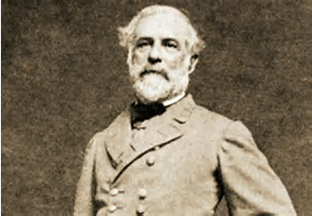
For those of you who are into name dropping, it may be useful for you to understand your relationship to Robert E. Lee when you make your pilgrimage to The Plains this summer. (At that time, you will perhaps notice that all of the side streets in The Plains are named for Southern Generals; Ewell St., Stuart St., Lee St. etc. The name Robert E. Lee still opens a few doors here.
Robert E. actually has quite a lengthy relationship with The Plains. He spent much of his boyhood at Kinloch (a farm just Northeast of town) with Thomas Turner, his relative and guardian. Apparently Lee named his iconic horse, Traveller, after a favorite horse he rode as a boy at Kinloch (Fancy Traveller). During the War, Lee’s wife and daughters sought refuge at Kinloch.
I figured this out a few years ago for my son Harry. He, and each of the Green Mont offspring of his generation “L”, is a first cousin, 6 generations removed, to Robert Edward Lee (1807-1870).
William Henry “Harry” Rust (1995- ) is the son of Henry Lewis Rust (1953- ) who is the son of William Fitzhugh Rust II (1914-1991) who is the son of Mary Elizabeth Lee Fleming (Rust) (1886-1967) who is the daughter of Richard Bland Lee Fleming (1848-1929) who is the son of Mary Elizabeth Lee (Fleming) (1827-1901), who acquired Green Mont in 1877 and was the daughter of Richard Bland Lee II (1797-1880) who was the son of Richard Bland Lee I (1761-1827) and first cousin to Robert Edward Lee (1807-1870) who was the son of Maj. General Henry “Light-Horse Harry” Lee III (1756-1818) by his second wife, Anne Hill Carter. “Harry” Leeʼs first wife (and also second cousin) was Matilda Ludwell Lee, daughter of Phillip Ludwell Lee of Stratford Hall, where R. E. Lee was born. See….it’s simple.
Maj. General Henry “Light-Horse Harry” Lee III, my Harryʼs great-great-great-great-great- great uncle, older brother to Charles and Richard Bland Lee I, attended the College of New Jersey (now Princeton University). At the outbreak of the Revolutionary War, he joined the Continental Army as a Captain. In 1778 he received the nickname “Light- Horse Harry” for his horsemanship as a Major in the cavalry unit known as Leeʼs Legion. He had achieved the rank of Lt. Colonel by 1781 and was present at Cornwallisʼs surrender at Yorktown. From 1786-1788, he was a delegate to the Congress of the Confederation. From 1789-1791, he served in the General Assembly. From 1791-1794 he served as the 9th Governor of Virginia.
Henry Lee III, Charles and Richard Bland Lee I are all the grandsons of Captain Henry Lee I. Thomas Lee (1690-1750), the older brother of Henry Lee I and Harryʼs great- great-great-great-great-great-great-great uncle, was the builder of Stratford Hall, built between 1725-1730. The town of Leesburg, Virginia is purportedly named in honor of him by two of his sons who were founders and trustees. He also started a concern known as The Ohio Company with business partners Lawrence and Augustine Washington, the father of General George Washington. Two of his sons, Richard Henry Lee (1732-1794) and Francis Lightfoot Lee I (1734-1797) were signers of the Declaration of Independence.
Light-Horse Harryʼs first younger brother, the Hon. Charles Lee (1758-1815), was the Attorney General during both the Washington and Adams administrations. The next younger brother was Richard Bland Lee I, Harryʼs great-great-great-great- great grandfather. He was northern Virginiaʼs first representative in the U.S house of Representatives, holding that office from 1789 to 1794 after which he was re-elected to the VIrginia House of Representatives. Richard Bland Lee Iʼs son, the Hon. Zaccheus Collins Lee (1805-1859) was the U.S. Attorney General from 1848-1851.
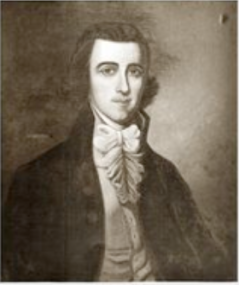
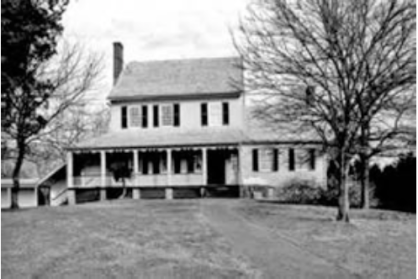 Richard Bland Lee I (1761-1827) The Sully Plantation (ca. 1794-1799)
Richard Bland Lee I (1761-1827) The Sully Plantation (ca. 1794-1799)
Richard Bland Lee I was the builder of “Sully Plantation” (ca. 1794-1799) in northern Virginia on land that is now part of Dulles Airport; some 3111 acres of land that was first acquired by his grandfather Captain Henry Lee I (1691-1747) and passed down to him and his younger brother, Theodorick Lee (1766-1849) through their father Henry Lee II (1730-1787). Richard, like George Washington, whom he idolized, applied modern methods of farming designed to diversify production and to halt depletion of the soil. This was very revolutionary in an era of monoculture tobacco farming.
Robert E. Leeʼs father, “Light-Horse Harry”, experienced calamitous financial setbacks due to bad investments and, in 1809, was placed in debtors prison. His brother, Richard Bland Lee I, came to his aid and he was thus released. In 1810, Henry Lee IIIʼs now impoverished family moved to Alexandria, Va and took up residence in a small house on Cameron St. In 1811 they moved to another house in Alexandria owned by a relative, William Henry Fitzhugh. This house was located on Oronoco St. This house has come to be known as the Lee-Fendall House. Ironically, Henry “Light-Horse Harry” Lee had once owned the lot that this house was built on. He had sold it to his cousin Phillip Fendall in 1794 for $300. He was Governor of Virginia at that time. Keep in mind, Henry Lee III was a Maj. General in the U.S, Army in 1798–1800 and he served in the U.S. House of Representatives from 1799 -1801. Yet, just eight years later, he was in debtors prison.
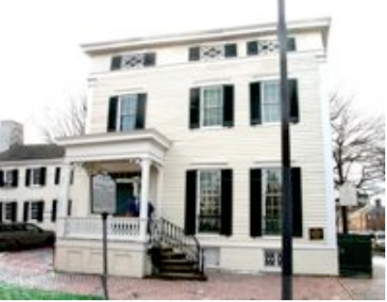
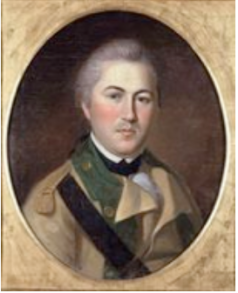
The Lee-Fendall House ca. 1785 Henry “Light-Horse Harry” Lee III
Richard Bland Lee I sold Sully to his 2nd cousin, Francis Lighthorse Lee II, in 1811 as he had gotten deeply in debt through his efforts to aid his brothers, Charles and Henry Lee III, who had both fallen on financial hard times. Richard Bland and Elizabeth Lee initially moved to a home in Alexandria, and then to a country home called “Strawberry Vale” near Scott’s Run (the current site of Tysonʼs Corner), and finally to Sixth and N Streets, SW in Washington, DC.
In 1812, Henry Lee III was gravely wounded in a political riot in Baltimore. He had been beaten and tortured by an angry mob. While still recovering, he traveled to the West Indies, leaving his nearly penniless wife to support their six children. He never returned home. He died in Georgia in 1818, when R. E. Lee was eleven.
The family relied heavily on family and friends for their support. It was largely due to the powerful influence of William Henry Fitzhugh that Robert received an appointment to West Point. Robert E. Lee was 22 years old when he graduated in 1829. The summer of 1829 was marked by his motherʼs death and the beginning of his courtship of Mary Anna Randolph Custis (1808–73), great-granddaughter of Martha Washington, by her first husband, and step-great-granddaughter of George Washington.
Mary Custis refused Lee the first time he asked to marry her. Her father did not believe the son of the disgraced “Light-Horse Harry” Lee was a suitable man for his daughter. He ultimately gave his consent and Robert and Mary married on June 30, 1831, at Arlington House, her parents’ house just across from Washington, D.C. They had seven children between 1832 and 1846.
Col. Richard Bland Lee II, the son of Richard Bland Lee I, was also a noted military commander in both the U.S Army and, later, the Army of the Confederacy. He was Robert E. Leeʼs first cousin.
Sully was sold out of the Lee family, in 1838, after Francis Lightfoot Lee II had failed at farming. Pretty hard company to fall in the shadow of. Poor Francis Lightfoot Lee II, who never successfully made a go of anything, had a breakdown in 1820 and was ultimately institutionalized at the Pennsylvania Hospital in Philadelphia, probably due to the pressures of chronic underachieving.
Since 1959, Sully has been operated as a Fairfax County Historical Park. My sister, Roberta Jeffries, is currently on the Sully Board of Directors.
In 1857, having been posted far from home and family for many years, Lee took a 2 year leave of absence from the army and returned home to take over management of the faltering Arlington plantation of his ailing father-in-law, George Washington Parke Custis. This had been his familyʼs home throughout his entire married life. It was then known as the Custis-Lee Mansion

 The Custis-Lee Mansion Arlington House Stratford Hall
The Custis-Lee Mansion Arlington House Stratford Hall
On March 28, 1861, Lee was promoted to the rank of Colonel in the U.S Army. Those orders were signed by President Abraham Lincoln. Meanwhile, Lee had ignored an offer of command from The Confederate States. On April 18, 1861, Lee turned down an offer of promotion to the rank of Major General in the Union army that was being amassed to defend Washington in the fight against the southern states that had seceded from the
Union. Lee replied, “I look upon secession as anarchy. If I owned the four millions of slaves in the South I would sacrifice them all to the Union; but how can I draw my sword upon Virginia, my native state?” Lee resigned from the U.S. Army on April 20 and took up command of the Virginia state forces on April 23, 1861. On January 31, 1865, three months before Appomattox, Lee was promoted to general-in-chief of Confederate forces.
All three of Robert E. Leeʼs sons served in the Confederate Army. George Washington Custis Lee served as Major General and aide-de-camp to President Jefferson Davis. William Henry Fitzhugh Lee served as Major General in the cavalry. Robert E. Lee, Jr. served as Captain in the Rockbridge Artillery.
The Custis-Lee Mansion had been seized by Union forces during the war and turned into Arlington National Cemetery; maybe to spite Lee. I had heard somewhere that the first thing that the Union soldiers did was to cut down all the beautiful trees around the house, like shaving Aslanʼs beard (C.S. Lewis)
From April to June 1865, Lee and his family resided in Richmond at the Stewart-Lee house. He accepted an offer to serve as the president of Washington College (now Washington and Lee University) in Lexington, Va. and served from October 1865 until his death (in 1870). On December 25, 1868, Lee finally received a pardon for his role in the Confederacy, restoring his U.S. citizenship. In 1955, Arlington House, the former Custis Lee Mansion, was dedicated as a National Monument to Robert. E. Lee.
In 1870, Dr. Robert Fleming Fleming, my paternal great-great grandfather, purchased the Lee-Fendall house and moved his family from Philadelphia to Alexandria. His son, Richard Bland Lee Fleming, was 22 at the time of the move. This house, the same one that Robert E. Lee had lived in as a boy, remained the property of my great-great grandmother, Mary Elizabeth Lee Fleming, until her estate was settled between 1901-1903. It was while living at the Lee-Fendall house that Mary Fleming, in 1877, purchased Green Mont for her eldest son, R. B. Lee Fleming.
As a gift to us, my father gave all four of his children a lifetime membership in the Lee Society of Virginia. It is not a very exclusive club, and they donʼt have a gym or pool. I canʼt recall what my family member designation number is but Iʼll try to dig it up if anyone wants to join. I imagine there are hundreds, maybe thousands, of first cousins six generations removed. Thatʼs not to say itʼs not a close relationship.
If I have any of this wrong, someone please straighten me out.
added August 18, 2017: I have just re-read this in the light of the recent events in Charlottesville, Virginia: the clash of protests and counter-protests surrounding the pending removal of the statue of Robert E. Lee from the University of Virginia campus.
I have many roots in the South, as well as the North and find the entire concept of enslaving another being to be incomprehensible and abominable. Many of our founding fathers and statesmen came of age and made history in an era when slavery was not only accepted but sanctioned. As I said; incomprehensible and abominable.
R. E. Lee made, for himself, a very difficult personal and moral choice in deciding whether to accept President Lincoln’s promotion to command of the army of the North, or to fight on behalf of his native state of Virginia; part of a confederacy that he did not support. Each of us, alone, are responsible for the choices we make. We are remembered for them.
I did not live in those times and I truly can’t imagine what it must have been like under the shadow of slavery. In researching and writing these pages I have come across family wills in which inheritances included human beings. I have to swallow hard when I read these documents. I do know that I was proud when I came across an instance, or two, where a landed and affluent ancestor freed their enslaved and provided them some means of their own. (I can’t conceive of what could have been thought to be to an appropriate or adequate recompense.)
I don’t really know how to express all that I feel when racism and supremacism show themselves as they did in Charlottesville last weekend. Robert E. Lee has earned a rightful place in history. At the same time, our history of slavery and racism can not be honored and glorified. If this is either the intent or the effect of a statue of Robert. E. Lee, or any member of the Confederacy, it, without question, should be removed, or, at least, revised. Initially I thought removing these monuments would be a rather superficial gesture not really striking at the root of the current issues. However, the more I learn about the origins of many of these statues, the more strongly I feel about the need for their removal. (see Fitz Brundage’s article in the link that follows).
Several weeks ago I was watching the Tavis Smiley Show and he had on as his guest the French film director Luc Besson. I can’t remember how the conversation came around to it, but Luc Besson was stating that, on the whole, he felt the societies of the world seem to be moving in a positive direction with regard to human rights issues. He suggested that if you looked at the last several hundred years, you would see a slow but definite improvement. He quickly corrected himself and said ” that is, not including the last six months.” (a reference to the first six months of the Trump presidency)
From what I have read, Robert E. Lee was a decent and honorable man who, I believe, would be loath to find his image being used by anyone, in any way, as an icon of division and supremacy. I wish I could say the same about our current leadership.
Please post your thoughts on this.
From William F. Brundage ; August 18, 2017:
Thanks to you, Henry, and others for raising this matter. It didn’t come up at our reunion, but then Charlottesville hadn’t happened yet.
As luck would have it, this topic is one to which I have devoted a fair portion of my professional career. Many moons ago (13 years now) I wrote a book devoted to the contest over historical memory in the South and since 2010 I and a team here at UNC have been building a digital archive/website devoted to cataloging the historical monuments that clutter the NC landscape. You might be surprised to learn that there is no comprehensive inventory for historical monuments in any US state; NC is now the first to have a more or less satisfactory inventory.
I mention all of this not because my opinions on these matters are more valid or important than anyone else’s but rather just to share my gratification that we Americans are now, finally, having this conversation. During the past week I have been sharing my thoughts on television, radio, and print. Here is a crystallization of them that appeared today:
https://www.vox.com/the-big-idea/2017/8/18/16165160/confederate-monuments-history-charlottesville-white-supremacy

Henry, this post is AMAZING…I hope everyone takes the time to read it! I am going to ‘resend’ it to all of my nephews as I know they will find it fascinating. I have always bragged about the Robert E. Lee connection and will continue to do so!
LikeLike
Wonderful history!
LikeLike
This story brings many threads together very concisely. As we all know, real life is much more complicated than the idealized mythologies that condense around a person’s historical reputation. As it was with Light-Horse Harry, so it was with Robert Edward.
Even though he might eventually have supported re-unification or deplored slavery, Robert E. Lee was a creature of his native culture who firmly believed that Whites were naturally superior to black Africans. There is evidence that Col. Lee had on at least a few occasions dealt rather harshly with slaves under his charge on the Custis plantation. Nothing too unusual for that time and place, especially for a man who was accustomed to strict military discipline, but a distinct departure from the kindly personality generally ascribed to Marse Robert.
As for the current anguish over the monuments, we must remember that these things are nothing more than artificial public instruments of political and cultural persuasion, not the actual flesh and blood of those persons depicted astride their mounts or standing at parade rest. The statuary can come or go as civic opinion ebbs and flows, but the personal deeds and memories are for families, friends, admirers and historians to actively record and pass along. That’s exactly what we are doing here and in conversations with our children.
LikeLike
A minor correction–the statue of Robert E. Lee in Charlottesville, Va wasn’t on the grounds of the University of Virginia but downtown in a one-block park called Lee Park which was donated to the city in 1917 (the statue dates to 1924) by philanthropist Paul Goodloe McIntire. It was finally removed to an undisclosed storage location on 7/10/21 (https://apnews.com/article/charlottesville-robert-e-lee-statue-removed-2efbc5e13b74e2545a0f6642e2384308).
LikeLike